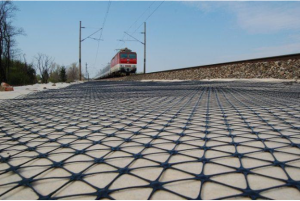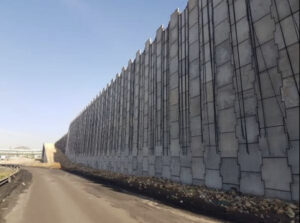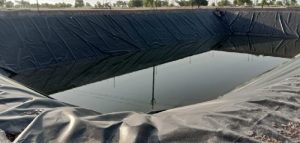Geosynthetics Products for Ground Performance Improvement

Geosynthetics goods have the properties of so-called custom-made materials, which are recognised to perform well in certain applications. The stability of the applied structure and practical applications such as constant new methods and new technologies have a direct link with the long-term performance of these goods. Composite goods, environmentally friendly products, environment adaptable products, hybrid, or smart products are being used in infrastructure projects as the need for high-performance products grows. The majority of geosynthetics products are produced from polypropylene, polyester, or polyethylene synthetic polymers.
There are several types of geosynthetics products that may be utilised to improve ground performance. Each one is described in detail below.
Geotextiles for better ground performance
Over the last fifteen years, geotextiles have grown more popular as a type of geosynthetic material. The material’s biodegradation resistance is a key reason for its success in more than 80 applications. Geotextiles are fabrics in the classic sense, but not in the way you might think. Natural fibres such as cotton, wool, and silk are not used. Geotextiles are synthetic fibres that may be manufactured into a nonwoven needle felt fabric that is flexible and porous. To different degrees, they are permeable to water movement.
Geotextiles have been created for at least 100 different applications; nevertheless, the fabric must always fulfil at least one of four distinct functions: separation, reinforcement, filtration, and/or drainage. One of the two main categories of geosynthetics is geotextiles. Synthetic fibres, rather than natural fibres like cotton, wool, or silk, are used in these fabrics. As a result, they are less prone to biodegradation. Standard weaving machinery is used to create flexible, porous textiles, or the synthetic strands are matted together in a random non-woven way. Some are knitted as well.
Geogrid for better ground performance
Geogrid is a type of geosynthetic material that may be used for reinforcing, stabilising, and filtering applications. Geogrids are mostly used for reinforcement. Reinforcement might be uniaxial (strength in one direction) or biaxial (strength in both directions) depending on the application (strength in all directions). They are graded based on a variety of performance characteristics such as tensile strength, junction efficiency, and brand name. The stabilisation of weak soils during site work is one of the most popular uses for a geogrid. Construction projects frequently run upon weak, damp soils that are unsuitable for construction. Traditional solutions include removing and replacing the poor material (over-excavation), placing a thick layer of aggregate or other granular material as a bridge layer, or chemically treating the soil to increase its strength. Geogrids use filtering and stabilising features to give a simpler, more cost-effective solution.
Geonet for better ground performance
A geonet is a geosynthetic material made up of integrally linked parallel sets of ribs that are layered atop identical sets at varying angles to allow liquids or gases to drain in-plane. Geonets can be used to gather liquids or gases. All applications that need drainage/collection of gas and leachates (mine and landfill) as well as filtering of sediments contained within these liquids are typical uses for these items. Transnet® has been particularly designed for use in high-load applications such as landfill cells and other areas where compression resistance is essential. Geonets are used in road construction, restoration, and repair to improve the condition of the road surface, reduce washboard development, and primary and secondary reflected cracking. Geonets are a mesh structure made up of overlapping threads/bands (ranging in diameter from 3 to 15 mm) arranged at a constant angle (60-90°). This produces holes with a width ranging from 10 to 200 mm. They’re made by either pressing a thermoplastic polymer (typically high-strength polyethylene) or welding threads/bands together.
Ground performance enhancement using geocomposites
Geocomposites are multi-layered geosynthetic composites. These combinations outperform individual layers in terms of functionality, interface friction angles, and installation speed. They can offer drainage, protection, strengthening, filtration, and barrier functions while substituting costly and rare mineral resources with proper design. A geocomposite is a factory-fabricated unit made up of geotextiles, geogrids, geonets, and/or geomembranes. Any of these four elements can also be mixed with another synthetic material (for example, distorted plastic sheets or steel wires) or even the earth. Geocomposites include, for example, a geonet or geospacer with geotextiles on both surfaces and a GCL made up of a geotextile/bentonite/geotextile sandwich. This category highlights the engineer’s and manufacturer’s most innovative efforts. There are various application areas, and they are continually expanding. The primary functions include all of the previously stated geosynthetic functions: separation, strengthening, filtration, drainage, and containment.
Improved ground performance using geomembranes
Geomembranes are utilised in the garbage sector, as well as in environmental, hydraulic, transportation, and oil and gas applications. Continuous polymeric sheets are the most frequent kind. A geomembrane is a synthetic membrane liner or barrier with a very low permeability that is used in conjunction with any geotechnical engineering material to regulate fluid (or gas) movement in a human-made project, structure, or system. Geotextiles can be impregnated with asphalt, elastomer, or polymer sprays, or as multilayered bitumen geocomposites. The most popular geomembranes are continuous polymer sheet geomembranes.
Improved ground performance using geosynthetic clay liners
GCLs (geosynthetic clay liners) are hydraulic barriers made in a factory from a layer of bentonite or another low-permeability material, which is supported by geotextiles and/or geomembranes and mechanically held together by needling, stitching, or chemical adhesives. Any seepage from landfills must be collected and properly disposed of due to environmental restrictions; otherwise, pollution of the nearby ground water might cause severe environmental and/or ecological concerns. The GCL will be more successful in retaining seepage inside the landfill if the hydraulic conductivity is low. Bentonite that is mostly made of montmorillonite or other expansive clays (>70%) is favoured and utilised in GCLs. A typical GCL would be made up of two layers of geosynthetics sewn together, with a layer of natural or processed sodium bentonite in the middle. To improve strength, polyethylene or geomembrane layers or geogrid geotextiles materials have been integrated into the design or utilised in place of woven and/or non-woven textile geosynthetics.



